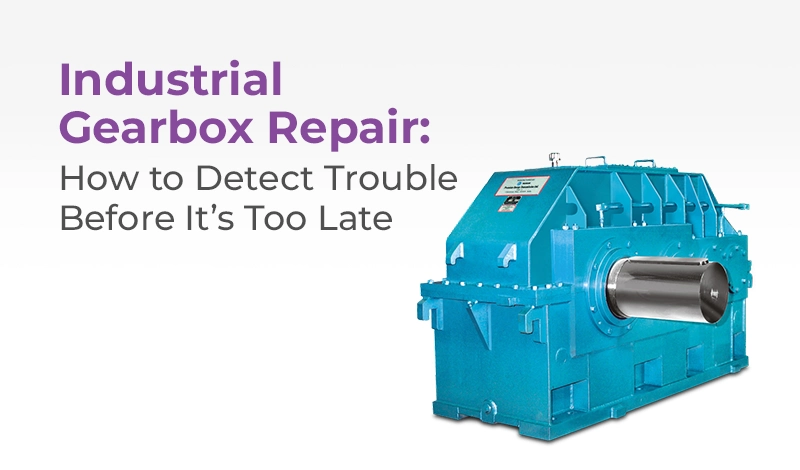
Industrial Gearbox Repair: How to Detect Trouble Before It’s Too Late
Your industrial gearbox is the heart of any power transmission system. Whether driving a conveyor belt, a crane, a mixer, or a production line, it ensures smooth torque transfer and operational efficiency. But constant stress, vibration, and heat slowly hamper gearboxes.
It is the timing that goes wrong quite often. Many teams don’t catch the early warning signs until the unit is already close to failure. By then, a small issue has escalated into an expensive shutdown.
The smarter approach is different: keep an eye on the signs, act early, and let repair services step in before “minor” wear becomes catastrophic damage.
When Noise Isn’t Normal
A gearbox under load usually has a steady hum. But once you hear grinding, rattling, or sudden knocking — that’s a red flag.
- Possible causes: Misaligned gears, bearings wearing out, chipped gear teeth, or simply oil that’s no longer doing its job.
- Why it matters: Ignore it, and small surface damage can escalate into broken teeth or complete seizure.
- What to do: Don’t let it run “a little longer.” Shut down, inspect, and get a service center to confirm the root cause.
Vibration You Can’t Ignore
Slight vibration is normal, but when it grows stronger — enough to be felt through the housing or the connected machinery — it’s often pointing at something deeper.
- What’s behind it: Loose mountings, shaft misalignment, bearing cracks, or unbalanced gears.
- The risk: Constant vibration not only accelerates gearbox wear but also stresses surrounding equipment like motors and conveyors.
- Next move: Get a vibration analysis done. It’ll show whether the problem is alignment, bearings, or balance.
Running Too Hot
If the gearbox housing feels hotter than usual, or alarms trigger, you’re likely dealing with poor lubrication, overloaded bearings, or insufficient cooling.
- Heat thins out oil.
- Thin oil means metal-to-metal contact.
- Metal-to-metal means accelerated wear.
Check the oil first, but don’t stop there. A thermal inspection is needed if temperature isn’t dropping.
Leaks That Cost More Than Oil
An oil puddle beneath the gearbox or visible dripping seals isn’t just messy — it’s a warning.
Common culprits: Worn seals, pressure build-up, or even tiny cracks in the housing.
The real risk: Once the oil escapes, internal gears are exposed to friction and heat. Failures follow quickly.
Action: Replace seals immediately, check housing integrity, and top up only with recommended fluids.
When Oil Tells the Story
Gearbox oil is one of the best “health reports” available. If it turns black, smells burnt, or looks milky/foamy, something’s wrong — water ingress, overheating, or metal debris are likely culprits.
Regular oil sampling is often overlooked, but it’s the most cost-effective way to catch trouble early. If the oil’s compromised, flush the system and send a sample for analysis before refilling.
Hesitation at Start-Up
Machines that hesitate, jerk, or shudder when starting often reveal gearbox misalignment or internal wear. In heavy-duty applications like mixers or crushers, this shouldn’t be ignored. Unchecked, it may progress toward shaft deformation or tooth slip — both expensive to fix once they reach that stage.
Signs of Weak Output
When torque feels reduced, or the system takes longer to reach speed, think of it as the gearbox “losing strength.” Causes range from worn gears to oil that’s lost viscosity.
Even a small decline in torque pushes motor loads higher and wastes energy. Don’t wait for an outright failure; a load test and rebuild often restore full output.
Backlash That’s More Than Tolerance
Every gearbox has a little play, but when shaft movement feels loose or delayed, there’s deeper wear at play — damaged teeth, misaligned shafts, or bearing erosion. Excess backlash compromises precision and accelerates gear wear. If you notice this in inspection, don’t delay: it’s a classic sign the gearbox needs reconditioning.
Why Acting Early Pays Off
Delaying repair rarely saves money. Instead, risks pile up:
- Tooth breakage = sudden, costly downtime
- Bearing seizure = complete shutdown
- Thermal distortion = shafts and housing damage
- Oil contamination = spreads into motor and fluid circuits
- Higher motor load = wasted energy and burnout risk
Early intervention means lower bills, less disruption, and a safer operation.
Premium Care’s Gearbox Repair Expertise
At Premium Care, we’ve been working with gearboxes for over six decades. From helical to worm, bevel to planetary, we service a wide range across steel, cement, mining, and power industries.
Our services include:
- Fault diagnosis and root-cause analysis
- Gear re-profiling and bearing replacement
- Shaft and housing reconditioning
- Dynamic balancing & precision alignment
- Oil flushing and seal replacement
- Full load testing with detailed inspection reports
What makes the difference? OEM-quality spares, trained technicians, and service centers designed for fast turnaround.
Final Word: Don’t Wait for the Breakdown
Gearboxes rarely fail overnight. They signal trouble well in advance — if you know what to listen for. The earlier you step in, the cheaper and faster the fix.
If you’ve noticed noise, vibration, leaks, or heat in your equipment, it’s time to bring in professionals. With regular repair and proactive care, you’ll keep your gearbox reliable, extend its life, and avoid costly shutdowns.



